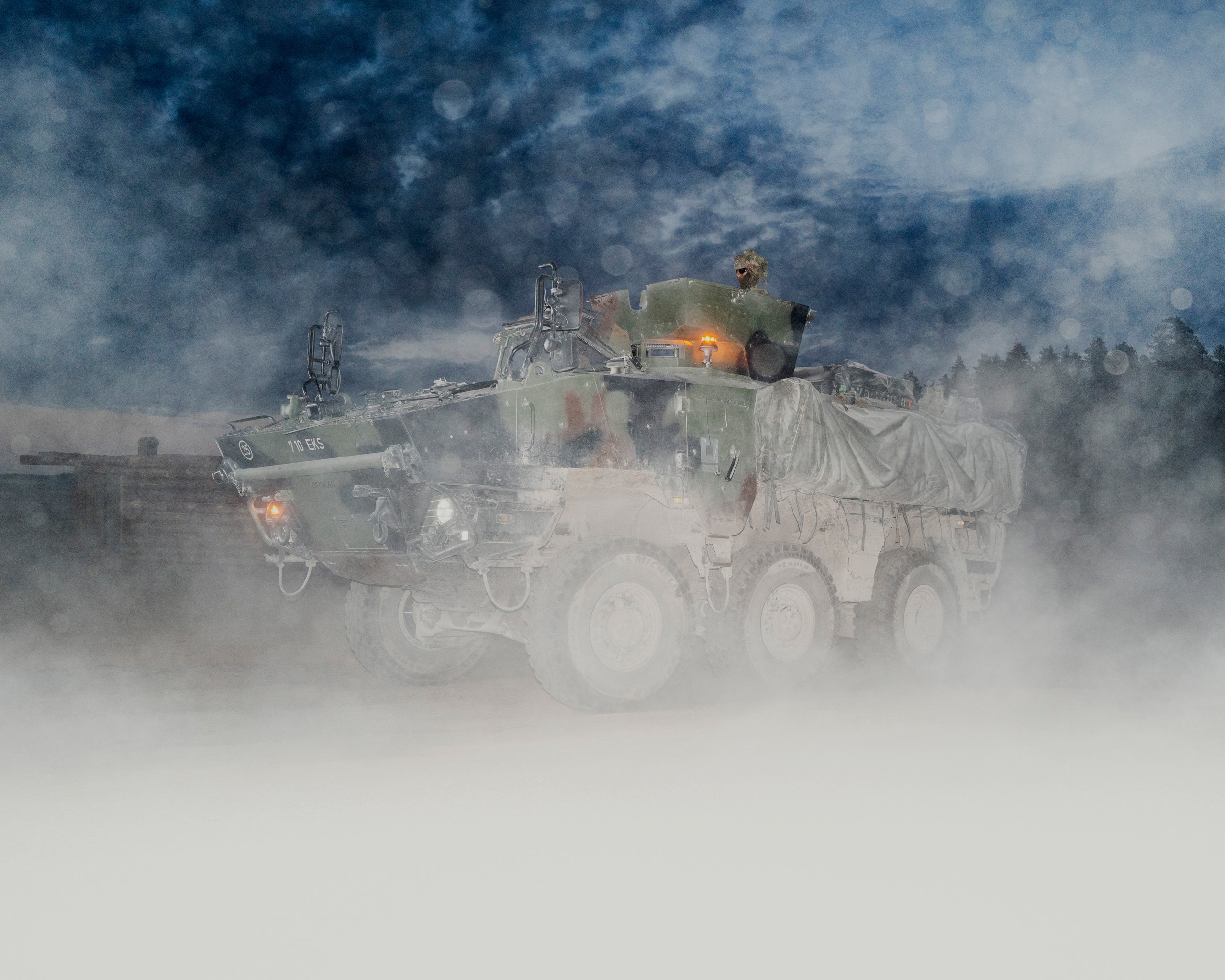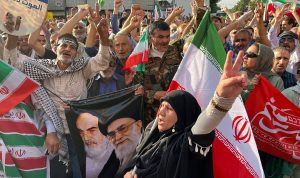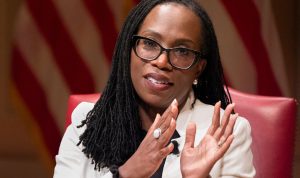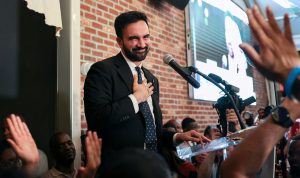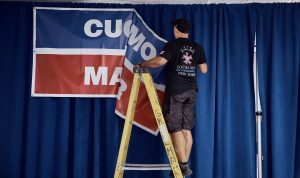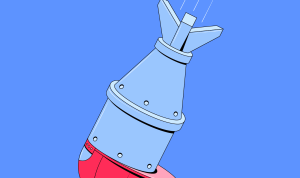The headquarters of the North Atlantic Treaty Organization, in Brussels, with eight crisscrossing glass-and-steel wings, was designed to resemble a set of interlocking fingers—a reference to what its architect called “the coming together of all nations in one common space.” Inside, the allocation of that space reflects certain geopolitical realities. The nine-person delegation from Iceland, the alliance’s only member without a standing army, occupies a half-dozen offices; France has a whole floor; Germany has two. The U.S. mission, with a staff of more than two hundred, representing a global force deployed in nearly a hundred and fifty countries, takes up an entire five-story wing.
One morning this spring, on an outdoor walkway that leads to what is known as the building’s Public Square, I passed a twisted knot of rusted steel, a remnant of the World Trade Center’s North Tower which was collected after the 2001 terrorist attacks.NATOdubbed the artifact the 9/11 and Article 5 Memorial, a testament to the sole instance in the alliance’s history in which its leaders have invoked the collective-defense clause in its founding charter. Article 5 is the core principle of the alliance, stating, “The Parties agree that an armed attack against one or more of them in Europe or North America shall be considered an attack against them all.” During the next two decades, twenty-nine non-U.S.NATOmilitaries deployed soldiers to Afghanistan, more than a thousand of whom died.
When theNATObuilding was officially unveiled, in 2017, Donald Trump, as the recently elected U.S. President, gave a dedication speech for the Article 5 memorial. During his Presidential campaign, he had seized on the fact that, thoughNATOmembers had committed to spending two per cent of their G.D.P. on defense, only five of them were hitting that target. Trump called the situation “unfair,” saying at one rally, “We’re protecting countries that most of the people in this room have never even heard of.” In Brussels, he gestured at “the commitments that bind us together as one,” but never explicitly endorsed Article 5. Privately, he expressed disapproval of theNATObuilding itself. John Bolton, who was then Trump’s national-security adviser, recalled the President once saying, “All this glass—one shot from a tank, the whole thing would collapse.”
In 2022, after the Russian invasion of Ukraine,NATOformally identified Russia as the “most significant and direct threat to Allies’ security and to peace and stability in the Euro-Atlantic area.” In response, its members pledged hundreds of billions of dollars in additional defense spending and deployed tens of thousands of troops to what the alliance calls its eastern flank—countries near Russia’s borders. The U.S. alone moved twenty thousand additional soldiers to Europe. But Trump has often expressed a more complicated view of Russian aggression, at times even seeming to treat the Russian President, Vladimir Putin, more as a potential partner than as a threat. On the campaign trail last year, he suggested that, if aNATOally underspent on defense, the U.S. would not provide military support in the case of a Russian attack. “I would encourage them to do whatever the hell they want,” he said of Russia. “You don’t pay your bills, you get no protection. It’s very simple.”
Since returning to the Presidency, Trump has sought to dramatically rewrite the terms of America’s commitment to European security. He is now pushing for member states to spend five per cent of their G.D.P. on defense. In February, during a visit toNATO, his Secretary of Defense, Pete Hegseth, said that European leaders “should take primary responsibility for defense of the Continent.” This spring, NBC News reported that the Trump Administration was preparing to move a sizable portion of American forces stationed in Europe to Asia and other regions, and that it might not fill the position of Supreme Allied Commander Europe, orSACEUR,NATO’s top military position, which has been held by an American since the founding of the alliance.
Anders Fogh Rasmussen, the former Prime Minister of Denmark, who wasNATO’s secretary-general from 2009 to 2014, told me that the alliance is in an “existential moment,” on par with what it went through at the end of the Cold War. Only now, he said, “the tectonic plates moving beneath our feet are first and foremost in Washington, D.C.”
Trump’s chief interlocutor inNATOis its current secretary-general, Mark Rutte, who took up the job in October, after fourteen years as Prime Minister of the Netherlands. Rutte is fifty-eight, with rimless glasses, a sweeping side part, and a wide politician’s smile. He has long cultivated an image as a modest and hardworking public servant. Upon arriving in Brussels, he declined to live in the grand town house that has served as the secretary-general’s residence since the nineteen-eighties, preferring to stay in an apartment elsewhere in the city and use the official residence for meetings and receptions. Rutte’s relationship with Trump is informed by his instincts for cautious disagreement and diplomatic finesse. One of his advisers told me that the secretary-general believes his primary responsibility is to “keep the family together.” The U.S., the adviser went on, “is the member of the family we all need to stay safe.”
Rutte agreed to speak with me at the town house this spring, as he was preparing for a meeting with Kaja Kallas, the European Union’s top diplomat. I joined him on a cream-colored couch in a sunny room facing a garden. A selection of cookies was set out; coffee was poured from a silver carafe. I asked Rutte how he planned to satisfy an American President who seems to scoff at the whole notion of collective security. Rutte was, as usual, in a chipper, buoyant mood. After a self-effacing take on his own job (“I always laugh to myself when anyone calls me secretary-general—that is a title usually reserved for Communist Parties”), he repeated a line he’s used many times, in various forms, during the past few months. Trump, he assured me, is “totally committed toNATO.”
The President, he went on, is merely saying something that Rutte himself has often toldNATO’s member states: “If we want to stay safe from threats and adversaries like Putin or China or North Korea or Iran, then we have to spend more.” The pressure from Washington, Rutte said, is an “opportunity” forNATOmembers to build the defense capabilities they have neglected for decades. “There is a realization in Europe that we have to shift some of the burden between what the U.S. is doing and what Europeans can do more of themselves.”
In late June, Rutte will preside over a summit ofNATOleaders in The Hague, his home town. The main subject will be new targets for defense spending, but European leaders hope the Americans will clarify their own commitments to the alliance. At the official residence, I told Rutte that many of them had expressed concerns about the speed and scale with which the Trump Administration might draw down forces in Europe. “We agreed with the White House that there will be no surprises,” he said. “We’ll do it in a structured way.” He added, “I’m not responsible for everyone’s anxieties. I can take them into account, but I’m not led by them.”
Still, Rutte has attempted to minimize the opportunity for drama at the summit—proceedings will be kept short, and the final communiqué, expressing an agreed-upon conclusion, will be limited to a few paragraphs. The narrow focus is Rutte’s way of acknowledging the world-altering stakes. “This will be one of the most consequentialNATOsummits since the fall of the Berlin Wall,” he said. “To use Trump’s language, ‘huge.’ ”
The idea of a defensive alliance linking the United States and Europe began to percolate in the aftermath of the Second World War. European cities had been destroyed, their populations scattered; entire economies were on the brink of collapse. Across the Atlantic Ocean, however, the United States had become Europe’s de-facto hegemon. In 1946, Winston Churchill spoke of the U.S. as being “at the pinnacle of world power,” a position that came with “an awe-inspiring accountability to the future.”
The following year, President Harry Truman outlined the principles of what would become known as the Truman Doctrine, calling on “the United States to support free peoples who are resisting attempted subjugation by armed minorities or by outside pressures.” The Soviet Union, in the confusion and wreckage left by the war, was wasting little time installing client regimes in Eastern Europe. Truman hoped that, with U.S. military and economic support, a fractured and war-weary Continent could both achieve peace and hold off the Communists. General Hastings Ismay, Churchill’s chief military adviser during the war, who becameNATO’s first secretary-general, is credited with a remark that captured the alliance’s initial goals: “Keep the Soviet Union out, the Americans in, and the Germans down.”
With just fourteen articles, the North Atlantic Treaty, signed by twelve founding members in Washington, D.C., in April, 1949, is among the more concise documents of its kind. The United Nations charter has more than a hundred articles; the treaty governing the European Union has nearly three hundred and sixty. ButNATOwas not concerned with fisheries law or judicial processes; its goals were both more limited and more profound—to turn the world’s bloodiest landmass into its most peaceful, and to usher in an era of prosperity and social welfare unprecedented in human history. The signatories agreed to “eliminate conflict in their international economic policies” and to maintain an “individual and collective capacity to resist armed attack.” Article 5, on collective defense, defined the alliance’s purpose. “For those who seek peace, it is a guide to refuge and strength,” the U.S. Secretary of State, Dean Acheson, said in a speech at the signing ceremony, held in the State Department’s auditorium. “For those who set their feet upon the path of aggression, it is a warning.”
From the outset, however, American leaders were wary of becoming permanently entangled in European security affairs. In 1950, Dwight Eisenhower, who had commanded Allied Forces in Europe during the Second World War, becameNATO’s firstSACEUR. He was adamant that the presence of U.S. troops in Europe should be a mere stopgap until European states could muster their own forces. “We cannot be a modern Rome guarding the far frontiers with our legions,” he wrote in 1951. Less than a decade later, Eisenhower, by then the U.S. President, lamented that American troops appeared destined to undergird peace in Europe forever. “The Europeans now attempt to consider this deployment as a permanent and definite commitment,” he told his successor asSACEUR, an American general named Lauris Norstad. They were, he added, close to “making a sucker out of Uncle Sam.”
The nuclear age added immense gravity to the American commitment. If war erupted with the Soviet Union, andNATOforces were quickly outmatched, the U.S. would be risking not only the lives of troops stationed in Europe but also the lives of people at home, who were now within reach of Soviet ballistic missiles. This uncomfortable fact gave rise to debates over the trade of Boston for Berlin. As Henry Kissinger, who would become Richard Nixon’s Secretary of State, put it, no American President was likely to risk the life of a housewife in Kansas to protect that of one in Hamburg. In 1966, Charles de Gaulle, the French President, pulled France out ofNATO’s unified military command so that the country could develop its own nuclear deterrent, with the proverbial button situated in Paris, not Washington. (France only fully rejoinedNATOin 2009.) “There is an inherent tension in an alliance in which the major security provider is located three thousand miles away from where conflict is most likely,” Ivo Daalder, who served as U.S. Ambassador toNATOfrom 2009 to 2013, told me. “The core problem is the same today as it was in the Cold War.”
The collapse of Communism in Eastern Europe and the fall of the Soviet Union, while an obvious victory forNATO, raised new questions about the alliance’s necessity. “I expectedNATOto dwindle at the Cold War’s end and ultimately to disappear,” Kenneth Waltz, an influential political theorist of Realpolitik, later wrote. Instead, Waltz observed,NATOhad become like the March of Dimes, which was initially founded to fight polio: “Having won the war against polio, its mission was accomplished. Nevertheless, it cast about for a new malady to cure or contain.” In the case ofNATO, that meant extending the alliance to the newly free parts of Europe. “You could imagineNATOmembers deciding, Job’s done, let’s go home,” Daalder told me. “But they thought, Wait a minute,NATOdidn’t just deter war—it provided a security blanket for prosperity. If we did that for Western Europe, why can’t we do the same for Eastern Europe?”
For the Czech Republic, Hungary, and Poland, all of which entered the alliance in 1999, it wasn’t just the benefits of joining the global economy that looked attractive but also the promise of protection against Moscow. That was even more true for the Baltic states—Estonia, Latvia, and Lithuania—which joinedNATOfive years later, after being occupied by the Soviet Union for half a century. Among the new members,NATO’s mission became one of reassurance. “To bring about economic and political transformation, they couldn’t be worrying about security problems to their east,” Daalder said. “And, at the time, it felt like that project could be achieved relatively cost-free.”
Ahead of the 2008NATOsummit, in Bucharest, the Bush Administration strongly backed the ascension of Georgia and Ukraine to the alliance. Members in Central and Eastern Europe—united in their suspicion of Russia—supported the idea, but a bloc ofNATO’s older members, led by France and Germany, were skeptical. They feared that the countries had not yet met the necessary political conditions and were wary of destabilizing relations with Moscow. During the summit, a compromise was hashed out. Rather than offer Georgia and Ukraine an actionable plan for membership, the alliance issued a declaration promising that they would “become members ofNATO” in the indeterminate future. Putin became fixated on this promise, however unlikely it was to be implemented, as a prime example of what he considered Western encroachment on Russia’s sphere of influence. In hindsight, the declaration “put Ukraine in the worst possible position,” Daalder said. “It offered something to Ukraine that was completely meaningless but put it squarely in the crosshairs of the Kremlin.” Meanwhile, he said, the alliance was setting itself up “to appear to be making decisions on which it couldn’t follow through.”
The Supreme Allied Commander Europe is what’s known as a dual-hatted position. The person who holds the role also serves as the head of the U.S. European Command, so theSACEURis, in other words, a commander forNATOand the U.S. at the same time. Strictly speaking, otherNATOmembers deal with theSACEUR. But the power and import of the role stems, in large part, from the occupant’s job atEUCOM. “SACEURis the big man, the demigod, the embodiment of American military power in Europe,” a European diplomat stationed atNATOheadquarters told me. General Philip Breedlove, who wasSACEURfrom 2013 to 2016, said that European diplomats and military officials would often visit his command headquarters, in Mons, Belgium, and tell him, “I’m not here to visit theSACEUR—I need to talk to the commander of U.S. European Command.”
In 2014, less than a year into Breedlove’s tenure, Russian soldiers without insignia on their uniforms—“little green men,” as they were popularly known—infiltrated and eventually occupied Crimea.NATOmembers in Eastern Europe pleaded for a meeting with Breedlove. “They were asking, ‘O.K., Mr.SACEUR, what are you gonna do? We’re next,’ ” he told me. “They were scared.”
Breedlove presented a range of possible options toNATO, none of which were adopted. The alliance operates according to consensus; an objection from any single member is enough to block an initiative. At the time, many European countries were still attached to the post-Cold War status quo, in which Russia was considered more of a trade partner than an adversary. France had an active deal worth hundreds of millions of euros to sell amphibious assault ships to Russia; Germany was the largest consumer of Russian gas in Europe and relied on those imports to fuel its manufacturing and industrial base. “There was quite a division,” Breedlove told me, between older members “who wanted to keep things, let’s say,tranquilo,” and the Eastern European states that joined in the nineties and two-thousands, “who were saying, ‘Invasion is imminent!’ ”
In the end, Breedlove came up with a compromise, not as theSACEURbut as the head ofEUCOM. That March, with the approval of President Barack Obama and the Pentagon, he pulled U.S. F-15C Eagle fighter jets from a base in the United Kingdom to police airspace above the Baltic states. Within hours, the first planes were in the sky, while others waited in Lithuania to replace them, forming what is known as a combat air patrol. “The truth is,” Breedlove said, “most European forces were not ready for that kind of deployment, that fast.” OtherNATOmembers, in particular Denmark and the U.K., decided to join the mission and sent their own planes. “The rest ofNATOgot a bit anxious that they weren’t involved,” Breedlove said. After a few weeks, the air patrols became part of an ongoingNATOoperation, still led by Breedlove, only now asSACEUR.
Later that year,NATOran a simulation to see how long it would take European militaries to move reinforcements, especially armored brigades, in the event of a Russian advance. Fabrice Pothier, thenNATO’s director of policy planning, told me that officials confronted a thicket of bureaucracy and regulations governing the movement of military equipment across European borders. “To get these brigades across Germany, it would take basically a year just to get the paperwork done,” he said. Jens Stoltenberg, who was then secretary-general, was incredulous. He hadNATOplanners create a map of Europe using three colors—red, amber, and green—to designate the amount of time required to move military forces across each member state. The result was “horrendous,” Pothier said. “It’s not that the Russians would win outright, but, rather, we would lose for what amounts to administrative reasons.”
That summer, at theNATOsummit in Wales, leaders agreed on a new readiness plan, which increased troop rotations to Central and Eastern Europe and instituted new measures to improve coördination and efficiency. Members also pledged to spend at least two per cent of their G.D.P. on defense. At the time, only three countries—the U.S., the U.K., and Greece—met this threshold; three years later, as Obama was leaving office, Poland and Estonia brought the number up to five. Obama spoke of the two-per-cent benchmark as “a goal that we have consistently set but not everybody has met.”
According toNATO’s estimates, in 2016, the U.S. defense budget accounted for seventy-two per cent of total military expenditures among allNATOallies. On the campaign trail, Trump was arguing that, in the post-Cold War era,NATOhad become “obsolete.” “Big statement to make when you don’t know that much about it,” he said, “but I learn quickly.” Most of his criticisms were about money. He told theTimesthat, if the U.S. was not “reasonably reimbursed for the tremendous cost of protecting these massive nations with tremendous wealth,” he would tellNATOallies, “Congratulations, you will be defending yourself.” In April, 2017, three months into Trump’s Presidency, he hosted Stoltenberg at the White House. Stoltenberg told him, “We are already seeing the effect of your strong focus on the importance of burden-sharing in the alliance.” Trump then said ofNATO, “It’s no longer obsolete.”
The following year, at theNATOsummit in Brussels, Trump joined the assembled heads of state for breakfast, where he called out Germany’s gas trade with Russia. “It certainly doesn’t seem to make sense that they paid billions of dollars to Russia and now we have to defend them against Russia,” he said. He widened his critique to the rest of Europe, saying, “They’re delinquent as far as I’m concerned.”
The next morning, during a meeting with his top foreign-policy officials, Trump asked Bolton, his national-security adviser, “Are you ready to do something historic?” (When I spoke with Bolton recently, he told me, “I just knew this was going to be bad.”) Later in the meeting, Trump declared, “We’re out.”
That afternoon, before a session devoted to the prospective membership of Georgia and Ukraine, Bolton implored Trump, “Go up to the line, but don’t cross it.” At the session, Trump launched into another critique of European underinvestment in defense and said that the U.S. was ready to “go our own way.” Bolton told me, “If I was a Catholic, I would have been doing my rosary.” Seemingly out of the blue, Trump declared that the two-per-cent spending target should be raised to four. Stoltenberg cleared the room, instructing only heads of state, ambassadors, and a handful of advisers to remain. “It was very important that the summit didn’t end in chaos,” he told me.
Rutte, then the Dutch Prime Minister, stepped in to pacify Trump. He suggested that the President look at the latest statistics on European defense spending, which was going up. “You can take credit for that, tell people it’s because of you,” Rutte told Trump, according to Timo Koster, a former Dutch diplomat andNATOpolicy official who was in the room. Trump quieted. “You could feel the relief,” Koster told me. Rutte, he said, “put the pin back in the grenade.”
At a post-summit press conference, a journalist asked Trump if he was considering a withdrawal fromNATO. “I think I probably can, but that’s unnecessary,” Trump said. In the end, he cited an additional thirty-three billion dollars thatNATOallies had promised to spend on defense—partly a reflection of budget decisions made before he became President—as vindication of his approach. “The United States’ commitment toNATOis very strong,” he told reporters. “The spirit they have, the amount of money they’re willing to spend, the additional money that they will be putting up has been really, really amazing to see.”
Bolton told me that Trump’s hostility toNATOwas simple: “As he sees it, we defend you, we don’t get anything out of it, and you won’t pay—so what’s the point?” Bolton himself has little patience for what he called “the airy-fairy stuff of our shared ideals.” Instead, he argued, the alliance offers both a strategic buffer—“It’s better to fight in Poland than in New Jersey”—and a way to project American power. He brought up the fact that Iceland, aNATOmember since its founding, has no military. An agreement from 1951 allows the U.S. to maintain a significant military presence on Iceland, a well-positioned staging point for the Arctic; in exchange, the U.S., throughNATO, is responsible for Iceland’s defense. “Iceland spends zero-point-zero per cent of its G.D.P. on defense,” Bolton said. “Should we kick Iceland out ofNATO? So you have no problem with Russia and China putting their own naval and airbases on Iceland once we leave?”
For manyNATOcountries, the election of Joe Biden as President represented a return to a calmer, more predictable relationship with the United States. At the 2021NATOsummit, in Brussels, Biden referred to Article 5 as a “sacred commitment,” and spoke, like Trump, of the 9/11 attacks, only this time he completed the thought. “NATOstepped up and they honored Article 5,” he said. “And I just want all of Europe to know the United States is there.”
In February, 2022, little more than a year into Biden’s Presidency, Russia launched its full-scale invasion of Ukraine. Suddenly,NATOwas faced with an actual land war in Europe. Individual member states dispatched military aid to Ukraine, an effort coördinated by the U.S. Defense Secretary, Lloyd Austin. (ANATOofficial close to Rutte told me that the Biden Administration “resisted quite robustly” the notion of other alliance members playing such a coördinating role.)NATOmembers, including the U.K., France, and Germany, increased the number of troops they had based in Eastern Europe. But the total number was still less than the twenty thousand soldiers the U.S. has sent, mostly to bases in Poland and Romania.
The deployments marked what a seniorNATOofficial called a “fundamental shift” away from an organization designed for regional security missions—sending small numbers of troops to do stabilization operations, with logistics and intelligence provided by the U.S.—to one dedicated to collective defense. “You’re defending your own homeland, your own territory,” the senior official said. “And it’s that much more intense because you’re potentially going to have to deal with a nuclear-armed peer opponent.”
Germany, for example, committed to increasing its presence in Lithuania from roughly a thousand soldiers to a full brigade, eventually reaching nearly five thousand soldiers. More significantly, the troops were stationed there permanently, on rotations lasting several years—the first long-term basing of German troops beyond the country’s borders since the Second World War. “We haven’t done anything like this in seventy years,” Falko Drossmann, a member of the German parliament’s defense committee, told me. “And to be honest no one wanted us to.”
For years, Germany has invested only modestly in its military. Carlo Masala, a professor at the University of Bundeswehr, in Munich, told me of aNATOexercise in 2021 in which the Bundeswehr, the German Army, deployed a brigade to Norway. “The rest of the German Army was left without winter gloves,” Masala said. “If you give the Bundeswehr a mission, they will fulfill it, but at the cost of readiness for the rest of the Bundeswehr.” Marcus Faber, the chair of the parliament’s defense committee, told me that, in the case of the brigade in Lithuania, “it may be hard for them, but it will be hard for the brigades in the rest of Germany, because they will be the ones giving up their equipment.”
Part of America’s outsized influence inNATOstems from what are known as strategic enablers, such as intelligence gathering and surveillance, targeting for long-range strikes, and air transport and air-to-air refuelling. “It’s not a question of whether or not you have enough bullets or tanks,” Julianne Smith, a former U.S. Ambassador toNATO, told me. “The enablers are the big systems that will allow you to use those types of weapons.”
According toNATO’s defense-planning principles, no one ally should provide more than fifty per cent of any given capability. But Rachel Ellehuus, a Pentagon representative toNATOduring the Biden Presidency, told me that the rule was regularly broken, with the U.S. providing, for example, the majority of heavy air transport and ground-based air-defense systems. The thinking, Ellehuus said, was “We’d rather you invest your limited defense dollars in something like fighter aircraft.” At times, the reliance has revealed vulnerabilities. In 2022, after Russia’s invasion, France prepared to move several hundred troops to Romania, but its military planners needed the U.S. to provide transport. The episode was “deeply troubling,” Smith said. “It’s not like we were asking them to deploy to the South China Sea.”
Europe’s biggest shortfall is in air defense. This spring, the Dutch chief of defense, General Onno Eichelsheim, told an audience at a panel on European security in Estonia that the Netherlands has only three Patriot air-defense systems—far fewer than is required to defend the entire country. In the case of a large-scale war, he said, “I can’t protect all the vital infrastructure in the Netherlands, so we have to make choices.” Amsterdam, Eichelsheim said, “is not important for me,” whereas Rotterdam is a major port and logistics hub. “So I’m going to protect that.” Germany has fewer than ten operational Patriot batteries at any one time, enough to cover the airspace over Berlin and one other city. “We can’t protect everyone,” Masala told me.
When Biden was President, deficiencies in European readiness did not always seem urgent. Constanze Stelzenmüller, an expert on transatlantic security at the Brookings Institution, told me that the “strategic mind meld” between the Biden Administration and European governments meant that both sides could convince themselves that America’s role inNATOcould be largely preserved. “Let’s be fair,” Ellehuus said. “The U.S. didn’t disabuse otherNATOmembers of the idea that it would underpin the alliance.” Liana Fix, an expert on Europe at the Council on Foreign Relations, tried to persuade Biden Administration officials to push Germany on defense issues. The response, Fix said, was “We don’t want to overpressure them. They should do it on their own time.”
Meanwhile, Fix also offered to help officials in the German Chancellery think through the implications of a possible second Trump Presidency. “We can hold workshops, write papers—we should prepare somehow,” Fix told them. The response, she said, was “stonewalling.” She added, “They didn’t want to talk about it, afraid of it becoming a self-fulfilling prophecy.”
The Biden Administration did, in fact, voice concerns that other allies were not spending enough or hadn’t developed sufficient defense capabilities. “They had a tone of frustration with people they thought weren’t pulling their weight,” a diplomat from a longtimeNATOmember state told me. “But they never issued direct threats. Rather, they appealed to a sense of allied kinship, that we should do better.” Inside the North Atlantic Council, the deliberative chamber inNATOheadquarters, there was little action taken to, as the diplomat put it, “fireproof the house” for a second Trump term.
Some members of the U.S. Congress, however, were alert to the threat posed by another Trump Presidency. In December, 2023, Biden signed a bill that prevented any U.S. President from withdrawing the country fromNATOwithout congressional approval. The legislation had originated in the Senate, where its Republican sponsor was Marco Rubio, who would go on to become Trump’s Secretary of State and national-security adviser.
Less than a month into Trump’s second term, Hegseth, the Secretary of Defense, visitedNATOheadquarters and told the other members that Europe needed to take charge of its own security. “Values are important,” he said. “But you can’t shoot values. You can’t shoot flags, and you can’t shoot strong speeches. There is no replacement for hard power.” Trump, he continued, “will not allow anyone to turn Uncle Sam into Uncle Sucker.” A Pentagon official said that John Healey, the British defense secretary, had seen a copy of Hegseth’s speech in advance. “He thought it would blindside a lot of folks,” the Pentagon official said. “He asked to tone it down.” (A Pentagon spokesperson said, “Secretary Hegseth did not soften his planned remarks . . . nor was he asked to soften his planned remarks.”)
NATOambassadors may have been alarmed by Hegseth’s language, but few were surprised by its central message. “It basically fit with what we thought would come one day,” the European diplomat said. “That the U.S. decides it cannot do everything everywhere.” When I asked Rutte about Hegseth’s speech, he brought up the acclaimed pianist Arthur Rubinstein: “You know what Rubinstein said—‘If I go onstage and I’m totally terrified, I cannot play. But if I go onstage and don’t have a little bit higher anxiety than when I was sitting at the dinner table, I will not be at my best.’ ” Rutte went on, “So there’s always a reason for us all to have a slightly elevated heartbeat.”
A day after Hegseth’s speech, Vice-President J. D. Vance appeared at the Munich Security Conference, an annual gathering of Western politicians and leading defense officials colloquially known as “Davos with guns.” The audience might have expected a speech outlining the new Administration’s defense policy for Europe, or even a plan for ending the war in Ukraine. Instead, Vance delivered a nearly twenty-minute lecture on what he described as a culture of anti-conservative censorship in Europe. It increasingly appeared, he said, that the Continent’s “old, entrenched interests” were “hiding behind ugly, Soviet-era words like ‘misinformation’ and ‘disinformation’ ” to suppress anyone who “might express a different opinion, or, God forbid, vote a different way—or even worse, win an election.” He mentioned a British man who was arrested while praying outside an abortion clinic; he also referenced Alternative für Deutschland, an ascendant far-right-wing party in Germany whose representatives were excluded from the Munich conference. “There is no security,” Vance said, “if you are afraid of the voices, the opinions, and the conscience that guide your very own people.”
Wolfgang Ischinger, a former chair of the Munich conference, described the reaction in the hall. “There was a degree of stunned silence,” he said. “If we don’t agree on what our fundamental values are anymore, why would America continue to offer us a security umbrella?” For European officials, the back-to-back speeches by Hegseth and Vance made it clear that Europe couldn’t just wait out the second Trump term and hope for a course correction in four years. “This Administration sees us Europeans as decadent, weak, woke,” the European diplomat told me. “What if what they really want is to undermine us? Honestly, the fact we even have to ask this question at all about a U.S. Administration already freaks a lot of people out.”
In a sense, the Pentagon official told me, that was the plan. “It was all highly choreographed,” he said. The Hegseth speech was meant to demonstrate that “the American security relationship with Europe is changing—not ending, but it does need to change.” Vance’s address was designed to push back on the moralizing of European leaders about matters in the U.S. The Pentagon official noted that the European Parliament had publicly rebuked the Supreme Court’s 2022 ruling overturning the right to an abortion in the U.S. “You’re lecturing us about this at the same time you’re banning political parties and outlawing certain types of speech,” he told me. “It’s all deeply hypocritical.”
Several European officials I spoke to compared Vance’s speech to one delivered by Robert Gates, the Defense Secretary under George W. Bush and Obama, at the Munich conference in 2007. “NATOis not a ‘paper membership,’ or a ‘social club,’ or a ‘talk shop,’ ” Gates had said. “It is a military alliance—one with very serious real-world obligations.” Four years later, during a farewell speech in Brussels, Gates was even more blunt, warning of “dwindling appetite and patience” in the U.S. for European nations “that are apparently unwilling to devote the necessary resources or make the necessary changes to be serious and capable partners in their own defense.” Future U.S. political leaders, Gates said, “may not consider the return on America’s investment inNATOworth the cost.”
At the time, Gates’s message barely registered, whereas the speeches this spring led to a prolonged cycle of anguished debate. “Gates asked nicely as a friend and was ignored,” Gideon Rose, the former editor ofForeign Affairs, who has been researching U.S.-European security coöperation, said. “Vance acted like a dick and abused them and got everybody’s attention.” A. Wess Mitchell, a top official at the State Department during Trump’s first term, told me, “I don’t share the fear of some Europeans that the United States is out to abandon them, but if that fear leads them to finally take defense more seriously, then maybe it’s not a bad thing. I’ve yet to see anything else that works.”
Across Europe, governments have been announcing defense investments that dwarf those made in the immediate wake of Russia’s invasion of Ukraine. In late February, after elections in Germany returned the center-right Christian Democratic Union to power, the party’s leader and presumptive Chancellor-elect, Friedrich Merz, said that the current U.S. Administration “does not care much about the fate of Europe.” As Chancellor, Merz continued, “my absolute priority will be to strengthen Europe as quickly as possible so that, step by step, we can really achieve independence from the U.S.A.” Three weeks later, the German parliament voted to suspend the country’s so-called debt brake for defense spending, undoing a key pillar of German fiscal policy and freeing up hundreds of billions of euros for military expenditures.
A week after the German election, the Ukrainian President, Volodymyr Zelensky, visited the White House. At the time, the Trump Administration was attempting to negotiate a ceasefire between Ukraine and Russia, with terms that heavily favored Putin: Ukraine would concede all the territory that Russia had occupied and give up its effort to joinNATO. Zelensky had rejected the proposal outright; in the Oval Office, Trump and Vance berated him. “Have you said thank you once?” Vance scolded. Afterward, the Administration briefly froze military aid to Ukraine. Within hours, the European Commission president, Ursula von der Leyen, proposed a plan to increase European defense spending by eight hundred billion euros.
Rasmussen, the formerNATOsecretary-general, acknowledged that European defense was entering a new era, which came with certain discomforts. But he welcomed the change. “For too long, we have relied on an old model that doesn’t work any longer,” he said. “Namely, a combination of cheap Russian energy, cheap goods from China, and cheap security from the United States.” In Europe, he added, “Trump’s election as President has been considered a bigger threat to our security than Putin’s invasion of Ukraine. That’s embarrassing.”
The Russian Army has suffered an estimated one million casualties since the invasion of Ukraine, and yet, because of the Kremlin’s accelerated conscription drive and recentering of the economy on the defense industry, it is now fifteen per cent larger than it was at the start of the war. Rutte often notes that Russia produces more ammunition in three months than the whole ofNATOdoes in a year. Estimates vary for how quickly Russia could ready its forces to mount a challenge toNATO. Rutte has spoken of a time horizon of five years, though much depends on the scale of the attack. This spring, Eichelsheim, the Dutch chief of defense, said at the conference in Estonia that, once the current phase of the war in Ukraine ends, Russia “will be capable of at least giving us a dilemma within a year.”
Putin’s ambitions aren’t necessarily dependent on military capability. “The goal of weakeningNATOis key,” a high-ranking European intelligence officer told me. “If Putin makes the decision to pursue that militarily, they don’t need much regeneration time; the capabilities are basically there.” But, the intelligence officer explained, Putin would likely try a host of other measures—political influence, sabotage—before turning to raw military force: “We assess war is the last option.” In June, Bruno Kahl, the head of Germany’s foreign-intelligence service, told an interviewer, “There are people in Moscow who no longer believe thatNATO’s Article 5 works. And they would like to test it.” Kahl continued, “They don’t need to send tanks for that. They just have to send ‘little green men’ to Estonia.”
The geography of the region would dictate Putin’s options if he wanted to pursue an attack. In Lithuania, Russian forces would likely try to close off the Suwałki Gap, a forty-mile stretch of land that separates the Russian enclave of Kaliningrad, on the Baltic Sea, from Belarus, a Russian ally that offers a staging point for its military. In Kaliningrad alone, Russia has permanently stationed more troops than Lithuania possesses in its entire armed forces. In Estonia, Russian forces could overtake the city of Narva, which is separated from Russia by a river, and march onward to the capital, Tallinn. A decade ago, in a series of war games run byRAND, it took Russian forces no more than sixty hours to reach Tallinn. Breedlove cautioned that the assessment needed updating. “That was beforeNATOstarted deploying capable forces forward,” he said. “And even more important than the number of people is the enabling kit that goes with them”—artillery, air defense, logistics, intelligence, and reconnaissance. “They’re quite prickly pears now,” Breedlove said of the Baltic states.
On a rainy afternoon in Tallinn this spring, I met with Hardi Lammergas, a lieutenant colonel in the Estonian Army, at the headquarters of the general staff. Lammergas was overseeing a large-scale exercise, code-named Hedgehog, to test the country’s defense plans. The Estonian Defence Forces had called up more than seven thousand reservists for the exercise, and a dozen otherNATOcountries and allies had also contributed forces. Sweden sent a battalion from a base in Latvia; France and the United Kingdom deployed reinforcements to Estonia by sea and on heavy trucks, as they would in the case of a real conflict. Lammergas explained that the exercise was premised on an end to the war in Ukraine. “If Russia wins, they emerge bruised but confident, and they might have the appetite to testNATOcoherence,” he told me. “Or they lose—which also means they’re bruised, but also angry, and they’ll want payback. The most logical place to try will be inNATO’s weakest spot: the eastern flank in the Baltic states.”
The armed forces currently stationed in the region are meant to repel a limited Russian attack. In a larger invasion, like the one envisioned in Hedgehog,NATOforces would likely choose to cede ground and try to hold defensible positions until reinforcements arrived—presuming Article 5 had been triggered—and mount a counterattack. This is the strategy Ukraine pursued in the early days of the war, especially around Kyiv, when Russian units quickly advanced and then became bogged down, cut off from their logistics and vulnerable to drone and artillery strikes. But Estonia is less than a tenth the size of Ukraine; there is only so far defending troops could pull back before they either surrendered the capital or ended up in the sea. “Our strategic rear is Sweden,” Lammergas said.
I paid a visit to an Estonian infantry battalion, whose soldiers were defending the Valgejõgi, a river fifty miles from Tallinn, which, for the Hedgehog exercise, was used as a proxy for the Narva River, on the Russian border. “If Russia wants to enter Estonia, they need to cross the river line,” Eero Aija, an Estonian officer who served multiple tours in Afghanistan, told me. “That’s obviously their first objective.” His radio crackled with English voices; Estonian soldiers communicate in English, for the benefit of the British soldiers embedded in their brigade, but also as a training measure for a wider conflict, when units from dozens ofNATOmilitaries would presumably be in the fight. Estonia effectively has no air force and, despite its position on the Baltic Sea, a navy of less than ten ships, most of which perform police and coast-guard functions. “There are no Estonian defense plans andNATOdefense plans,” Aija said. “NATOdefense plans are Estonian defense plans.”
Deeper in the woods, the Estonian forces were pushing through dense vegetation, “trying to get behind the enemy,” Kristjan Muuli, an Estonian captain, told me. Drones were circling overhead. Muuli, whose grandparents were banished to Siberia in the early forties by Soviet authorities, said that Estonia was incorporating lessons from the war in Ukraine: don’t make yourself an easy target (“Always park vehicles well away from defensive positions”); be aware of counter-drone strikes (“Don’t launch the drone from your position—go six, seven hundred metres away”); keep batteries on hand (“We always have to charge them—we never have enough”). Every now and then, a drone would drop a training grenade. Muuli tells the soldiers under his command, “If you’re within a fifteen- or twenty-metre radius, you’re dead.”
The next day, I travelled to the southeast, where a sprawling area of thick forest and farmland, wet and muddy with rain, had become a training ground. A mobile rocket launcher was parked behind a barn; soldiers in combat gear studied maps in the aisle of a village grocery store. The idea was that, in case Russia invades, the locals andNATOsoldiers should be accustomed to dealing with each other. Near a copse of pine trees, I met Brian Looper, a captain in the U.S. Army. He was commanding a company of armored fighting vehicles, which have been stationed in Estonia since February; for the exercise, Looper’s company was on the “red” team—that is, the invading army. (The defending side was the “blue” team.) “I tell my guys to pay attention to these roads, this mud, these forests,” Looper told me. “This is the ground where, if need be, you’re meant to fight.”
Looper was talking over the chugging rumble of a Bradley command vehicle. He pulled out a laminated map and gave an update on his unit’s movements to William Branch, a U.S. Army lieutenant colonel. Branch had come to Estonia from Poland, where he heads aNATOmultinational battle group that is integrated into a Polish brigade. Around a thousand soldiers, from Croatia, Romania, the U.K., and the U.S., serve under him. Branch is subordinate to a Polish general. “In the event of an Article 5 scenario,” he told me, “I would fall underneath myNATOcommanders and move out to the Suwałki Gap.” During training missions, he added, he and the soldiers under his command often call out, “Dla Polski”—“For Poland.”
As part of the red team’s objective of capturing southeastern Estonia and isolating Tallinn, Looper’s units had taken a series of key bridges and transport crossings. Early on, they also took out a mortar team of French troops. “We pissed them off pretty bad,” Looper said. The red team benefitted from what Branch called a “capabilities overmatch”—they had more heavy armor and more long-range fire than the defenders. “That’s very realistic,” Branch said, given the presumed capabilities of a Russian invasion force. But the point of Hedgehog wasn’t for the blue team to prevail; it was to identify vulnerabilities in the country’s defenses and correct them. Branch told me, “You want to learn those lessons in exercises, not during an actual fight.”
In March, when Rutte visited the White House, Trump greeted him warmly. “It’s great to be with a friend of mine,” Trump said, adding that Rutte was doing a “fantastic job” as secretary-general. Rutte praised Trump for his efforts to broker a ceasefire in Ukraine. “You broke the deadlock,” he said. “I really want to commend you for this.” He mentioned the upcomingNATOsummit in The Hague, saying, “I’d love to host you there in the summer and work together to make sure that it will be a splash, a real success, projecting American power on the world stage.”
Since the election, Trump has repeatedly stated his desire for the U.S. to annex Greenland, a territory of Denmark. “I think it will happen,” he told a journalist during Rutte’s visit. “I’m sitting with a man that can be very instrumental.” He added, pointing to Rutte, “We will be talking to you.” Rutte appeared unruffled at the suggestion that he might help oneNATOmember annex the territory of another. “When it comes to Greenland,” he said, unfurling a tight smile, “yes or no, joining the U.S., I would leave that outside this discussion, because I don’t want to dragNATOin that.” But, he added, Trump was “totally right” when it came to his concerns about security in the Arctic and the need to address Chinese and Russian activity in the region. When I asked Rutte about the exchange, he said, “If I want to be effective, in some discussions, it’s better for me to stay quiet when the cameras are rolling.”
The White House visit revealed a central dilemma facing not only Rutte but the alliance itself: even as Europe rearms, it is impossible to contemplate replacing the United States as the guarantor of Europe’s security. Alienating an American President, especially one as prone to impulsive outbursts as Trump, isn’t an option. “We try to cut him a lot of slack,” a diplomat from northern Europe stationed atNATOheadquarters said of Rutte. “He has a very difficult task and, well, perfect might not be on the menu.”
But it’s also true that Rutte largely agrees with Trump that Europe should become more self-reliant in matters of defense. “It’s not simply that Trump became President and all of a sudden people woke up,” he said. Rutte brought up the U.S. air strikes in Yemen in March, a response to a sustained campaign of attacks by Houthi rebels on international shipping vessels in the Red Sea. Jeffrey Goldberg, the editor ofThe Atlantic, was accidentally added to a Signal group of Trump Administration officials who were coördinating the strikes; he later published screenshots of the conversation. “I just hate bailing out Europe again,” Vance wrote in one message. Hegseth replied, “I fully share your loathing of European free-loading. It’s PATHETIC.”
In advance of the strikes, Rutte got a call from Mike Waltz, who was then Trump’s national-security adviser. (“It’s a tradition,” Rutte said. “The U.S. informs me as secretary-general before these big things start.”) Rutte’s reaction was not dissimilar to Vance’s. He knew that the shipping lanes in the Red Sea were used more by European companies than by American ones. “So why is the U.S. doing this?” Rutte recalled thinking. “Well, because the Europeans can’t.” The view is widely shared across the Continent. When I asked a top European foreign-policy official about the Signal chat, the official replied, “Frankly, itisan issue that only Americans are able to carry out an operation like that. It doesn’t seem healthy.”
In the meantime, most European governments have embraced the fact that they will have to spend more on defense. Twenty-twoNATOmembers now meet the two-per-cent target, compared with just eight in 2021. Poland is expected to spend 4.7 per cent of its G.D.P. on defense this year. (The countries closest to Russia tend to spend the most on defense, rendering Trump’s repeated claim that he will assist only thoseNATOmembers who meet the alliance’s spending pledges functionally moot.) Spain, with the lowest spending in all ofNATO, at 1.24 per cent of its G.D.P., has indicated it will hit the two-per-cent threshold this year, after previously promising to do so by 2029. Even Iceland has formed a parliamentary committee to revamp the country’s defense policy. (Last year, Russia spent an estimated seven per cent of its G.D.P. on defense.)
The Trump Administration has yet to clarify its plans to remove troops and equipment from Europe. “The United States is going to start pulling back forces, probably this year,” the Pentagon official said. “But I want to be clear: that doesn’t mean a complete withdrawal.” The official suggested that U.S.-force levels in Europe could end up resembling what they were before Russia’s 2014 annexation of Crimea. “It has to be orderly,” the official said. But, he added, “it’s not like we’re withdrawing from Iraq or Syria or Afghanistan—if we don’t replace the rotational brigade in Romania, does that mean the Russians are going to be in Bucharest the next day? No, that’s absurd.”
Trump’s current Ambassador toNATOis Matthew Whitaker, a former U.S. Attorney from Iowa who, after a failed run for Senate, served as an acting Attorney General in Trump’s first term. “He’s a great guy, folksy, personable,” the diplomat from a longtimeNATOmember state said. “His job is clearly to deliver on defense spending.”
In May, at the defense conference in Estonia, Whitaker told a roomful of Europeans, “I’m going to shoot with you straight.” The U.S. was going to reduce its troop presence in Europe, and Europe was expected to insure its own security. “This is going to happen, and it’s going to happen now,” he said. “This is going to be orderly, but we are not going to have any more patience for foot-dragging in this situation.” Later, Bruno Tertrais, the deputy director of a French think tank, quipped onstage, “Saying ‘orderly’ and ‘Trump’ in the same sentence is only mildly convincing.”
After the Trump Administration set its five-per-cent target forNATOmembers, Rutte voiced support for a spending formula in which countries would agree to a target of three and a half per cent for strict military spending—tanks, missiles, new troop formations—and an additional one and a half per cent for infrastructure projects that contain a military component, such as trains, roads, and cybersecurity. The proposal will be the subject of the upcomingNATOsummit in The Hague. Whitaker has endorsed the new terms, though he has warned that the smaller category of spending can’t be “a grab bag for everything that you could possibly imagine.”
This spring, multipleNATOofficials told me that any sense of anxiety about America’s contribution to European security was unfounded: after all, nothing has changed in terms of the allocation of hard power. “It’s been several months and not a single American boot has left these shores,” the official close to Rutte said. “If they intended a completely chaotic, mass withdrawal, then what are they waiting for?” In May, Ischinger, the former chair of the Munich conference, travelled to Washington for another event with Vance. This time, Vance came off as conciliatory, saying, “It’s completely ridiculous to think that you’re ever going to be able to drive a firm wedge between the United States and Europe,” whom he described as “on the same civilizational team.” Trump recently nominated Alexus Grynkewich, a lieutenant general in the U.S. Air Force, to serve as the nextSACEUR. The job will stay filled by an American after all. “It was never a real thing,” the Pentagon official said of rumors that the U.S. might hand over the role.
In June, I talked to Whitaker about his mission in Brussels. For the past seventy-six years, he said,NATO’s other members “have oftentimes relied on the United States to pay for European security.” Trump “wanted to equalize that relationship and sent me over here to do that.” This was not an ultimatum, Whitaker said. “We’re just pointing out that some countries are still underspending based on their commitments from eleven years ago. And we have to be honest with people—we have to say this is no longer acceptable.” He spoke of Russia’s “hot war” in Ukraine and America’s “hundred-year competition” with China: “This is not a time to be comfortable.” He sounded like a champion ofNATO, rather than a critic. His boss feels the same way, he said. “NATOis going exactly in the direction that President Trump would like.” ♦

